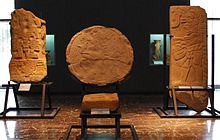Tenam Puente

Tenam Puente is a Maya site in the state of Chiapas in southeastern Mexico .
location
The ruins of Tenam Puente are located about 12 km south of the town of Comitán de Domínguez at an altitude of about 1700 m above sea level. d. M .; the regional airport of Comitán ( Aeropuerto Nacional de Comitan ) is about 8 km to the northeast. The nearest town is La Trinitaria on the CF190.
Toponym
The name Tenam Puente is a combination of the Nahuatl word tenamitl ('wall' or 'fortress') with the Spanish word puente ('bridge'), which, however, refers to a colonial finca formerly located nearby .
history
Although the site was already settled in the classical period (approx. 300–600 AD), there are many indications that it only experienced its heyday in the post-classical period (approx. 900–1200 AD) - especially at a time when the formerly important centers of Mayan culture in the region (including Palenque and Yaxchilán ) had already been abandoned.
Tenam Puente was first mentioned in a publication entitled Tribus y Templos by Frans Blom and Olivier Lafarge in 1928, but it was not until the 1960s and 1970s that the site was examined more closely and partially restored or reconstructed.
buildings
The most important monument of the archaeological core zone of Tenam Puente, which covers an area of around 30 hectares, comprises around 60 buildings, is the large temple pyramid (structure 7) , which is divided into nine steps, with its staircase in front. On the outer walls of the three upper levels, remains of the former stucco cladding can still be seen , which was probably originally painted; of the temple, which is also covered with a layer of stucco, only the base zone remains.
Another four or five-tier temple pyramid stands on a raised platform and forms - together with some palace substructures - the area of the so-called ' Acropolis '.
The place had three ball courts , two of which were reconstructed with their 'H' shape, which was particularly common in the classical and post-classical times. The side areas of the middle pitch are slightly raised and sloped - they were used to roll back the solid rubber ball and were probably not allowed to be entered by either the players or the spectators.
Two steles and a round stone disk were found in the area of the ball courts, which are now on display in the Museo Regional de Antropología y Historia by Tuxtla Gutiérrez . The persons depicted are probably ball players: the figure on the right appears to be wearing a yoke stone wrapped with plaited strips of fabric around his waist; the middle one is shown in a crouched position, but has raised her arms - just as if she had just played the ball with her shoulder. Both figures wear rich headdresses. The left figure is only partially preserved.
See also
Web links
- Tenam Puente - Photos + Info (Spanish)
Coordinates: 16 ° 8 ′ N , 92 ° 6 ′ W

